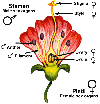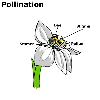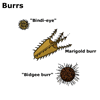|
Plant systems C: Reproduction and
flowering plants
As is the case for animals, flowering plants have systems to maximise
efficiency of reproduction to ensure the species survives through time.
Seeds and germination
 Seeds contain both a food source and a small embryonic
plant in a dormant state. Given a supply of freshwater and sufficient
warmth, the seed will germinate, with the plant root growing through
the water-softened seed coat and down towards water and the pull of
gravity. The shoot then grows upwards through the soil to light.
Seeds contain both a food source and a small embryonic
plant in a dormant state. Given a supply of freshwater and sufficient
warmth, the seed will germinate, with the plant root growing through
the water-softened seed coat and down towards water and the pull of
gravity. The shoot then grows upwards through the soil to light.
Seeds of some Australian native trees (e.g. wattles) only germinate
after bushfires. This ensures they only germinate when there is less
competition by other plants for space and light.
The flower
 The germinated seedling continues to grow and uses up its stored
food supply until it breaks through the soil surface, develops more
roots and green leaves, and can photosynthesise (see Plant
systems B: Photosynthesis, nutrition and respiration). It then grows,
matures and develops reproductive systems called flowers.
The germinated seedling continues to grow and uses up its stored
food supply until it breaks through the soil surface, develops more
roots and green leaves, and can photosynthesise (see Plant
systems B: Photosynthesis, nutrition and respiration). It then grows,
matures and develops reproductive systems called flowers.
 Some species have separate male and female flowers, but most produce
both pollen (male gametes or sex cells) as well as ovules (female gametes
or egg cells) on the same flower.
Some species have separate male and female flowers, but most produce
both pollen (male gametes or sex cells) as well as ovules (female gametes
or egg cells) on the same flower.
The "male" organ is the stamen with a stalk (filament) and
a large lobed tip (anther), where the pollen is produced.
The "female" organ (the pistil) includes the ovary where
the ovules are formed, and the sticky stigma on top of a stalk-like
style.
 Pollination Pollination
As plants cannot move about to mate, they rely on other organisms, wind,
or water to transport the pollen to other flowers. Cross-pollination
increases biodiversity in the offspring by mixing two parental types,
but some plants do self-pollinate.
- Vector-pollinated flowers are bright coloured, curious shapes, scented,
and contain nectar and plenty of pollen to attract insects and birds.
These pollen carriers (vectors) inadvertently get excess pollen on
them which wipes off onto the broad, grooved, sticky stigmas of other
flowers they visit. Many flowers have the arrangement of floral parts
to prevent self-fertilisation.
- Wind-pollinated flowers lack large, bright petals and scent, and
produce abundant pollen on long dangling stamens, from flowers well
above leaves (e.g. grasses) or flowers which emerge before the leaves
(e.g. many deciduous trees). The stigmas are long and feathery to
catch the wind-blown pollen thus increasing the chance of pollination.
Fertilisation
 When the pollen grain lands on the stigma of another flower of
the same species, a pollen tube grows down to fertilise the ovule, forming
the embryonic seed plant. The ovary area develops into a fruit enclosing
the seeds. Thus an apple with six seeds is formed from one flower which
was successfully pollinated by at least six pollen grains fertilising
six ovules.
When the pollen grain lands on the stigma of another flower of
the same species, a pollen tube grows down to fertilise the ovule, forming
the embryonic seed plant. The ovary area develops into a fruit enclosing
the seeds. Thus an apple with six seeds is formed from one flower which
was successfully pollinated by at least six pollen grains fertilising
six ovules.
Seed dispersal
 |
Seeds must be carried to other areas to reduce competition
between new seedlings for resources (light, space and water). This
may be on animal feet or fur (e.g. sticky burrs), by water or wind,
or via animals eating the fruits and dropping the indigestible seeds
elsewhere (e.g. plum or apple) or in faeces (e.g. tomato, blackberry). |
 |
Vegetative reproduction
Some plants can grow from cuttings, and runners.
As this involves only one parental type, it is a form of asexual reproduction.
It allows fast spreading of a successful "parent" but does
not increase biodiversity.
|